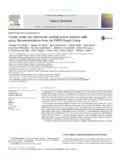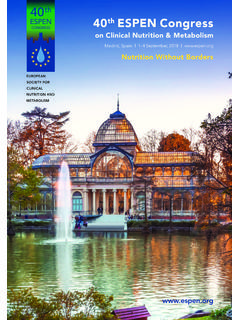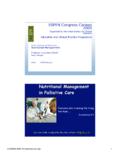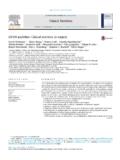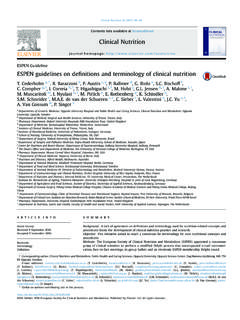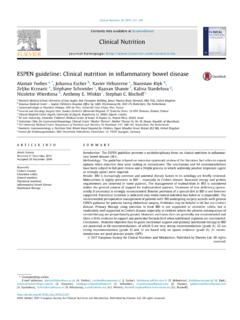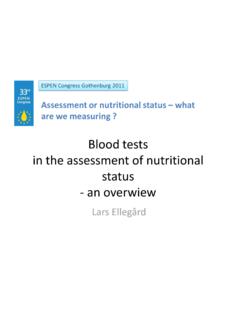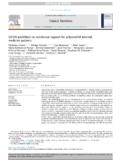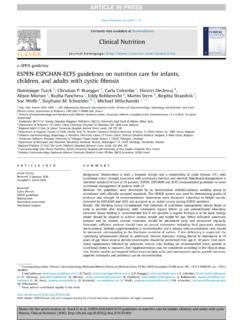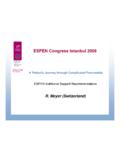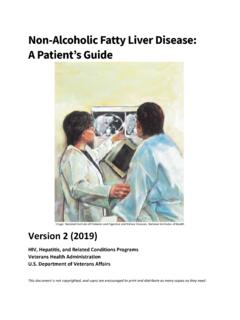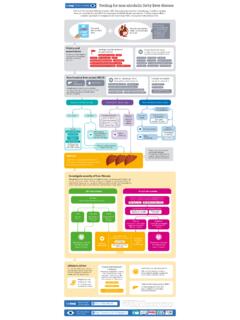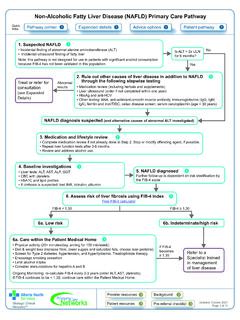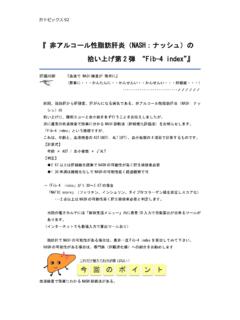Transcription of ESPEN guideline on clinical nutrition in liver disease
1 ESPEN guideline on clinical nutrition in liver diseaseMathias Plautha,*, William Bernalb, Srinivasan Dasarathyc, Manuela Merlid,Lindsay D. Planke, Tatjana Sch tzf, Stephan C. BischoffgaDepartment of Internal Medicine, Municipal Hospital of Dessau, Dessau, GermanybInstitute of liver Studies, King's College Hospital, London, United KingdomcDivision of Gastroenterology and Hepatology, Cleveland Clinic, Cleveland, OH, USAdGastroenterology and Hepatology Unit, Sapienza University of Rome, Rome, ItalyeDepartment of Surgery, University of Auckland, Auckland, New ZealandfIFB Adiposity Diseases, Leipzig University Medical Centre, Leipzig, GermanygDepartment for clinical nutrition , University of Hohenheim, Stuttgart, Germanyarticle infoArticle history:Received 14 December 2018 Accepted 18 December 2018 Keywords:SarcopeniaAcute liver failureFatty liver diseaseAlcoholic steatohepatitisCirrhosisTransplantations ummaryThis update of evidence-based guidelines (GL) aims to translate current evidence and expert opinion intorecommendations for multidisciplinary teams responsible for the optimal nutritional and metabolicmanagement of adult patients with liver disease .
2 The GL was commissioned andfinancially supported byESPEN. Members of the guideline group were selected by searched for meta-analyses, systematic reviews and single clinical trials based on clinical questionsaccording to the PICO format. The evidence was evaluated and used to develop clinical recommendationsimplementing the SIGN total of 85 recommendations were made for the nutritional and metabolic management of patientswith acute liver failure, severe alcoholic steatohepatitis , non-alcoholic fatty liver disease , liver cirrhosis, liver surgery and transplantation as well as nutrition associated liver injury distinct from fatty liverdisease. The recommendations are preceded by statements covering current knowledge of the under-lying pathophysiology and pathobiochemistry as well as pertinent methods for the assessment ofnutritional status and body composition. 2019 European Society for clinical nutrition and Metabolism. Published by Elsevier Ltd.
3 All IntroductionThe prognostic and therapeutic role of nutritional issues in themanagement of patients with liver disease has been known for long[1]and therefore, nutritional status was one of the variables in theoriginal prognostic score devised by Child and Turcotte[2]. Sincepublication of thefirst ESPEN guidelines (GL) on nutrition in liverdisease[3]and the subsequent updates[4,5]a considerable body ofnew evidence has accumulated necessitating an update of the the past twenty years new methods for the assessment ofnutritional status and the recognition of the prognostic role ofsarcopenia are just two among many other major achievementswhich are covered in the updated ESPEN GL that is based on thecurrent ESPEN guideline methodology[6]. In recognition of theincreasing disease burden from non-alcoholic fatty liver (NAFL) andnon- alcoholic steatohepatitis (NASH) the current GL hold a newchapter addressing the nutritional management of NAFL/NASH patients.
4 Furthermore, a second new chapter addresses clinicalquestions arising from nutrition associated liver injury (NALI)distinct from NAFL/NASH. In the current guidelines' working groupexperts from three global regions (Europe, America, Australasia)could base their work on the current GL of the German Society forNutritional Medicine[7]implementing the identical aim of the current GL is to translate current evidence andexpert opinion into recommendations for multidisciplinary teamsresponsible for the optimal metabolic management of patients withliver Target populationThis GL is aimed to address clinically relevant issues in thenutritional and metabolic management of adult patients with liverdisease.*Corresponding Plauth).Contents lists available atScienceDirectClinical Nutritionjournal homepage: 2019 European Society for clinical nutrition and Metabolism. Published by Elsevier Ltd. All rights nutrition xxx (xxxx) xxxPlease cite this article as: Plauth M et al.
5 , ESPEN guideline on clinical nutrition in liver disease , clinical nutrition , Target usersThis GL is intended to be used by health care providers involvedin the care of patients with liver disease , medical specialistsinvolved in the management of liver disease , family physicians,pharmacists, nurses, dieticians, nutritionists, as well as by medicalleaders and administrators of liver General methodologyThis guideline was developed in accordance with the standardoperating procedure for ESPEN guidelines and consensus papers[6]. It is based in part on the German guideline clinical nutrition inthe Gastroenterology (Part 1)eLiver [7], which was updated andextended by an international expert group consisting offive phy-sicians (MP, WB, SD, MM, SCB), one physicist (LP) and one nutritionscientist (TS).Based on the standard operating procedures for ESPEN guide-lines and consensus papers, thefirst development step of thisguideline was the formulation of so-called PICO questions toaddress specificpatient groups orproblems,interventions,compare different therapies and beoutcome-related[6].
6 Originally,59 PICO were created and split into seven main chapters General , Acute liver Failure , alcoholic steatohepatitis , Non-alcoholicSteatohepatitis , Cirrhosis , Transplantation and Surgery and nutrition Associated liver Injury . To answer these PICO questions,a literature search was performed to identify suitable meta-analyses, systematic reviews and primary studies (for details seebelow, search strategy ). The PICO questions were allocated tosubgroups/experts for further working. The group met 2016 inLjubljana, Slovenia, for one meeting on November 24 and 25, onoccasion of the EASL Monothematic Conference nutrition in LiverDisease on November 25 and 26, 2016. Finally, 106 recommenda-tions and statements were created. To grade the literature, thegrading system of the Scottish Intercollegiate Guidelines Network(SIGN)[8]was used. The allocation of studies to the different levelsof evidence is shown inTable 1. The working group added com-mentaries to the recommendations to explain and support the basisof the grades of recommendation were decided according to thelevels of evidence assigned (Table 2).
7 In some cases, a downgradingfrom the recommendation grades generated based on the levels ofevidence according toTables 1 and 2was necessary, e. g. due to thelack of quality of primary studies included into a cases are described in the commentaries accompanying therespective recommendations. The wording of the recommenda-tions reflects the grades of recommendations: Level A is indicatedby shall , level B by should and level 0 by can/may . The goodpractice points (GPP) are based on experts' opinions due to the lackof studies. For the GPP recommendations, the wording can bechosen applicable, the recommendations were assigned to theoutcome models according to Koller et al., 2013[9], seeTable 17th February and 23rd March 2017, an online votingon the recommendations was performed using the platform. Members of ESPEN guideline projects andof the ESPEN council (country representatives) were invited to voteand to provide comments. 64 recommendations reached anagreement>90%, 40 recommendations reached an agreement of>75e90% and three recommendation an agreement 75%.
8 Rec-ommendations with strong consensus (indicated by an agreementhigher than 90%, seeTable 4) were directly passed. All others werevoted on again during a consensus conference which took place on24th April 2017 in Frankfurt/Main, Germany. During this consensusconference,17 recommendations were changed into statements. 22of the recommendations/statements achieved an agreement of>90%, 13 an agreement of>75e90% and two an agreement of>50e75%. Six recommendations were rejected due to low agree-ment or by decision of the group and two additional recommen-dations were voted on. In total, the guidelines now comprise 85recommendations and 17 statements. In support of the recom-mendations and the assigned grade of recommendations, theESPEN guideline office created evidence tables of relevant meta-analyses, systematic reviews and (R)CTs. These evidence tablesare available online as Supplemental Materials to this Search strategyThe updated German S3- guideline on nutrition in liver disease [7]
9 Was produced according to almost the same rules as the currentESPEN guidelines, and therefore, the guideline Editorial Officedecided to use them as a base for the updated ESPEN , a new comprehensive literature search was performedfor the period 01-08-2011 through 22-11-2016 extending theAbbreviationsALFacute liver failureASHalcoholic steatohepatitisBCAA branched chain amino acidsCTcomputed tomographyDXAdual energy X-ray absorptiometryENenteral nutritionGLguidelineHCChepatocellular carcinomaHEhepatic encephalopathyICUintensive care unitIFALD intestinal failure associated liver diseaseLCliver cirrhosisLTliver transplantationMCTmedium-chain triglycerideMEDD Mediterranean dietMRTmagnetic resonance tomographyNAFLnon-alcoholic fatty liverNAFLD non-alcoholic fatty liver diseaseNALI nutrition associated liver injuryNASHnon-alcoholic steatohepatitisOLTorthotopic liver transplantONSoral nutritional supplementsPEGpercutaneous endoscopic gastrostomyPNparenteral nutritionPNAC parenteral nutrition -associated cholestasisPNALD parenteral nutrition associated liver diseaseREEresting energy expenditureRFH-NPT Royal
10 Free Hospital nutrition Prioritizing ToolRFH-SGA Royal Free Hospital SGASGA subjective global assessmentSMOFsoy-bean based lipid and olive oil and MCT-lipid andfish oilUDCA ursodeoxycholic acidVA study Veteran Affairs studyM. Plauth et al. / clinical nutrition xxx (xxxx) xxx2 Please cite this article as: Plauth M et al., ESPEN guideline on clinical nutrition in liver disease , clinical nutrition , search of the German guideline which covered the period01-01-2006 until 31-07-2011. The search was done for systematicreviews and (randomized) controlled clinical trials with the key-words andfilters presented inTable 5. After removal of duplicatesand abstracts, 830 articles remained from originally 957 hits andwere assigned to topics[1]acute liver failure[2], alcoholic steato-hepatitis[3], non- alcoholic steatohepatitis [4], liver cirrhosis[5],transplantation&surgery, or[6] nutrition associated liver and abstracts were screened using the following pre-defined inclusion/exclusion criteria:- paper is written in English- paper is a controlled trial or a systematic review- paper is a meta-analysisAfter the screening described above, 122 relevant articles weredetected.
